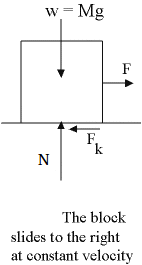Definition
Friction Force
The normal force is one component of the contact force between two objects, acting perpendicular to their interface. The frictional force is the other component; it is in a direction parallel to the plane of the interface between objects. Friction always acts to oppose any relative motion between surface.
For the simple example of a book resting on a flat table, the frictional force is zero. There is no force trying to move the book across the table, so there is no need for a frictional force because there is nothing for the frictional force to oppose. If we try to slide the book across the table, however, friction will come in to play.
For the simple example of a book resting on a flat table, the frictional force is zero. There is no force trying to move the book across the table, so there is no need for a frictional force because there is nothing for the frictional force to oppose. If we try to slide the book across the table, however, friction will come in to play.
Formula
Components of contact force

When two bodies are kept in contact, electromagnetic forces act between the charged particles at the surfaces of the bodies. Thus, each body exerts a contact force of the other. The magnitudes of the contact forces acting on the two bodies are equal but their directions are opposite and therefore the contact forces obye Newton's third law.
The direction of the contact forces acting on a body is not necessarily perpendicular to the contact surface. The resolution of contact forces in two components i.e. perpendicular to contact surface and along surface.
Perpendicular component is normal force and parallel component is friction.
R =
R - Contact force
The direction of the contact forces acting on a body is not necessarily perpendicular to the contact surface. The resolution of contact forces in two components i.e. perpendicular to contact surface and along surface.
Perpendicular component is normal force and parallel component is friction.
R =
R - Contact force
Definition
Rolling and sliding friction
When a body slides (moves with all its surface area in contact) over another body, the resistance faced is due to sliding friction. On the other hand, if a body rolls (moves with just a single point of its surface in contact) over another body, the resistance offered is a case of rolling friction.
Rolling friction is generally lesser than sliding friction. In rolling, the surfaces in contact don't rub against each other as they do in sliding friction. An example is the case of tires in vehicles. When they are moving on the road, some rolling friction acts on them. When the brakes are applied, rolling motion is reduced and sliding friction takes over to slow down the vehicle.
Rolling friction is generally lesser than sliding friction. In rolling, the surfaces in contact don't rub against each other as they do in sliding friction. An example is the case of tires in vehicles. When they are moving on the road, some rolling friction acts on them. When the brakes are applied, rolling motion is reduced and sliding friction takes over to slow down the vehicle.
Definition
Coefficient of kinetic friction

Coefficient of kinetic friction (as given in fig(1)) is defined by
Definition
Inclined Plane

Inclined Plane - "A slope or a flat surface raised at an angle in order to move heavy loads with less effort".
Ramps in hospital and slides in playground are example of Inclined Plane
Ramps in hospital and slides in playground are example of Inclined Plane
Definition
Screw

A screw is another type of inclined plane.
It is formed when an inclined plane wraps around a straight rod like structure, it has spirally grooved surface with a pointed end.
It is used to hold things together.
It is formed when an inclined plane wraps around a straight rod like structure, it has spirally grooved surface with a pointed end.
It is used to hold things together.
Definition
Wedge

A wedge is formed when two inclined planes are joined together such that one end is sharp and other is blunt. It is used to cut things.
A knife and Axe are examples of wedge.
A knife and Axe are examples of wedge.
Definition
Angle of Repose
The angle of repose is the steepest angle of descent or dip relative to the horizontal plane to which a body doesn't slide on a slope.It is found that a body on an inclined plane just starts sliding down if inclination is , the angle of repose (friction) is: We know,
Angle of repose = angle of friction
Also,
Also,
By trigonometry,
Angle of repose = angle of friction
Also,
Also,
By trigonometry,
Example
Lawn roller friction force

A lawn roller of mass m is pulled by a force of F inclined with the horizontal.
For vertical equilibrium,
th force of friction is given by
For vertical equilibrium,
th force of friction is given by
Example
Maximum Possible Static Friction
A horizontal force of is applied to a block of mass resting on a rough horizontal table. The value of coefficient of static friction between the block and the table for the block remains at rest []
Mass, . Friction is a self-adjusting force.So, normal reaction = .Since the block is at rest, so limiting friction force applied force.i.e., . But value of coefficient of static friction is fixed. We can definitely say that
Mass, . Friction is a self-adjusting force.So, normal reaction = .Since the block is at rest, so limiting friction force applied force.i.e., . But value of coefficient of static friction is fixed. We can definitely say that
| BookMarks |
0 Comments
Post a Comment